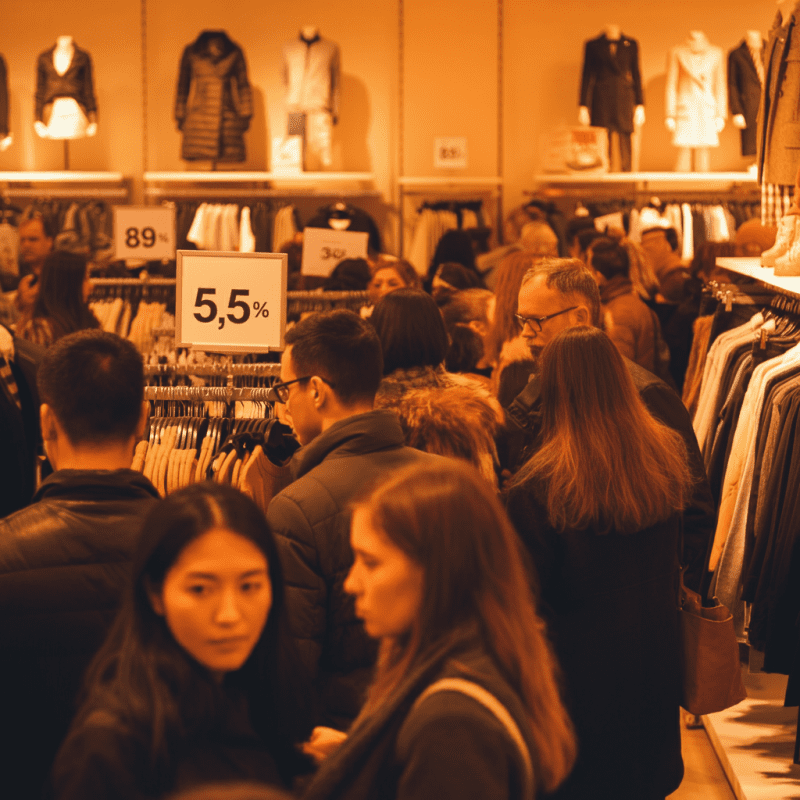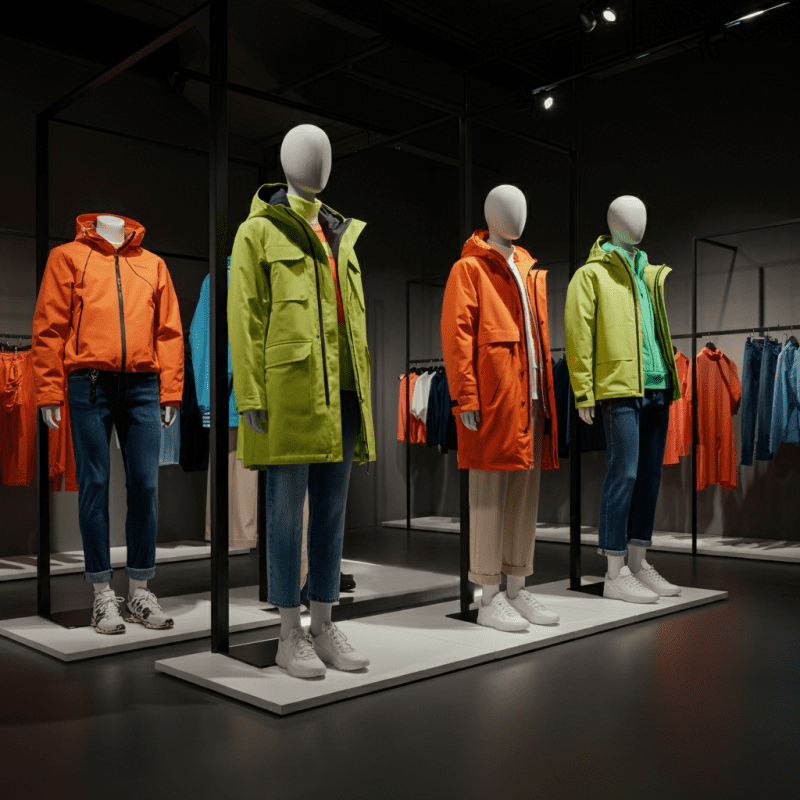
In recent years, the fashion retail landscape has undergone a significant transformation, with discount fashion emerging as a dominant force. The Role of Strategic Discounting in Fashion Retail is not merely a response to economic pressures but reflects a broader change in consumer behavior and expectations.
As inflation continues to impact purchasing power, consumers are increasingly gravitating towards budget-friendly options, making discount shopping a staple in their buying habits.
According to a report by [McKinsey](https://www.mckinsey.com/~/media/McKinsey/Industries/Retail/Our Insights/State of Fashion/2021/The-State-of-Fashion-2021-vF.pdf), the discount segment experienced a staggering 36% decline in sales during the pandemic, highlighting the challenges faced by retailers. However, as the market stabilizes, the allure of affordability has reignited interest in discount fashion.
The rise of discount fashion is also intertwined with the evolving consumer mindset, where frugality and conscious spending have become paramount.
Economic uncertainties, including geopolitical tensions and fluctuating markets, have led consumers to adopt a more cautious approach to spending, prioritizing value over luxury. This trend is further supported by a growing movement towards sustainable and ethical consumption, as consumers seek brands that align with their values while still offering affordability (Sinuate Media).
Moreover, the digital revolution has played a crucial role in shaping the discount fashion landscape. With the rise of e-commerce, consumers now have unprecedented access to a plethora of budget-friendly options, allowing them to compare prices and find the best deals with ease. As noted by Brandwatch, price sensitivity has become a key factor in purchasing decisions, with nearly 90% of U.S. consumers shopping from discount retailers.
This shift has not only democratized fashion but has also compelled traditional retailers to rethink their pricing strategies and inventory management practices.
As we delve deeper into the dynamics of discount fashion, it becomes evident that this trend is reshaping the retail landscape, challenging established norms, and redefining consumer expectations. The implications of this shift are profound, as brands must navigate the delicate balance between maintaining profitability and meeting the demands of a price-conscious consumer base. In this report, we will explore the multifaceted aspects of the rise of discount fashion, examining its impact on brand perception, inventory management, and the overall retail environment.
Table of Contents
- The Impact of Economic Factors on Consumer Behavior in Discount Fashion
- The Wallet-Watching Generation
- The E-Commerce Explosion
- The Thrift Store Renaissance
- The Rise of Dupes
- The Sustainability Dilemma
- The Role of Strategic Discounting in Fashion Retail
- Understanding the Discounting Landscape
- The Psychology Behind Discounts
- The Balancing Act of Brand Perception
- Inventory Management and Discounting
- The Long-Term Implications of Discounting
- Alternatives to Traditional Discounting
- Conclusion: The Future of Discounting in Fashion Retail
- The Future of Discount Fashion and Consumer Expectations
- The Shift Towards Value-Driven Shopping
- The Role of Social Media in Shaping Consumer Expectations
- The Importance of Sustainability in Discount Fashion
- The Rise of Digital Shopping Experiences
- The Challenge of Brand Loyalty in a Discount-Driven Market
The Impact of Economic Factors on Consumer Behavior in Discount Fashion

The Wallet-Watching Generation
In a world where the cost of living seems to be on a never-ending rollercoaster ride, consumers are tightening their purse strings like never before. The pandemic has left many feeling financially fragile, with 27% of consumers indicating they plan to trade down to more affordable items to save money ([McKinsey](https://www.mckinsey.com/~/media/McKinsey/Industries/Retail/Our Insights/State of Fashion/2021/The-State-of-Fashion-2021-vF.pdf)). This shift in spending habits has led to a surge in demand for discount fashion, as shoppers seek stylish yet budget-friendly options.
The rise of discount fashion is not just a fleeting trend; it’s a lifestyle choice for many. With the average consumer becoming increasingly price-sensitive, brands that offer value for money are winning the hearts (and wallets) of shoppers. In fact, the off-price retail sector is thriving, with established players like T.J. Maxx and Nordstrom Rack expanding their reach to capture this budget-conscious audience. The discount mindset is here to stay, and it’s reshaping the retail landscape.
The E-Commerce Explosion

If there’s one thing the pandemic taught us, it’s that shopping from the comfort of our couches is a game-changer. The e-commerce boom has transformed how consumers shop for fashion, with online sales skyrocketing. According to reports, the top 200 fashion companies saw a staggering 36% increase in e-commerce sales, reaching a total of $106 billion in 2021 (Osum).
This shift to online shopping has been particularly beneficial for discount retailers, who have quickly adapted to the digital landscape. Brands that were agile enough to pivot to online platforms during the pandemic have experienced significant growth in digital sales. As consumers continue to prioritize convenience, the expectation for seamless online shopping experiences will only increase. The discount fashion sector is capitalizing on this trend, offering easy access to affordable styles with just a few clicks.
The Thrift Store Renaissance
Thrifting is no longer just for the eco-conscious or the nostalgic; it’s become a fashionable way to save money while still looking fabulous. The rise of secondhand shopping has been fueled by economic pressures, with consumers seeking unique pieces at lower prices. In 2023, buying secondhand is expected to become even more mainstream, as shoppers look for ways to stretch their budgets without sacrificing style (Brandwatch).
This trend has also led to a fascinating phenomenon: the “thrift flip.” Consumers are not just buying secondhand items; they’re also getting creative by upcycling and personalizing their finds. This not only saves money but also allows for a unique expression of style. The thrift store renaissance is a testament to how economic factors can influence consumer behavior, leading to innovative and sustainable shopping practices.
The Rise of Dupes
In the world of fashion, imitation is the sincerest form of flattery—especially when it comes to budget shopping. As consumers become more price-sensitive, the demand for “dupes” (affordable knock-offs of high-end products) has skyrocketed. Shoppers are eager to find stylish alternatives to luxury items without breaking the bank. This trend has given rise to a new breed of brands that specialize in creating budget-friendly versions of popular styles.
The allure of dupes is undeniable; they allow consumers to stay fashionable while keeping their wallets happy. As the economy continues to fluctuate, the popularity of dupes is likely to grow, with consumers seeking out affordable options that don’t compromise on style. This shift in consumer behavior highlights the importance of value in the current retail landscape.
The Sustainability Dilemma
While consumers are increasingly focused on budget-friendly options, the desire for sustainability remains a significant factor in their purchasing decisions. According to a survey conducted by IBM in 2022, 51% of respondents indicated that sustainability is more important to them than it was a year prior (Brandwatch). However, the economic pressures of rising costs have made it challenging for many to prioritize sustainable fashion.
This creates a bit of a conundrum: consumers want to shop sustainably, but they also need to be mindful of their budgets. As a result, many are turning to discount retailers that offer sustainable options at lower price points. Brands that can effectively balance affordability with eco-friendly practices will likely find themselves in a prime position to capture the attention of today’s conscious consumers.
In conclusion, the impact of economic factors on consumer behavior in discount fashion is profound and multifaceted. As shoppers navigate a landscape marked by financial uncertainty, they are increasingly drawn to budget-friendly options that offer both style and value. The rise of e-commerce, the thrift store renaissance, the popularity of dupes, and the sustainability dilemma all illustrate how economic pressures are shaping the way consumers approach fashion. The discount fashion sector is not just a trend; it’s a reflection of a new normal where budget shopping reigns supreme.
The Role of Strategic Discounting in Fashion Retail

Understanding the Discounting Landscape
In the ever-evolving world of fashion retail, discounting has become a strategic tool that goes beyond simply slashing prices. It’s a delicate dance between attracting customers and maintaining brand integrity. Retailers are not just throwing markdowns at their products like confetti; they are crafting a well-thought-out strategy that influences consumer behavior and drives sales. According to a report, discounts can significantly shape how consumers perceive a brand, determining whether it’s seen as exclusive or accessible (FashionUnited).
The Psychology Behind Discounts
Discounts tap into the psychological triggers that drive consumer behavior. When shoppers see a “limited-time offer,” their brains go into overdrive, often leading to impulse purchases. This phenomenon is known as the “scarcity principle,” where the fear of missing out (FOMO) can compel consumers to buy items they might not have considered at full price. A study found that 60% of consumers are more likely to purchase an item if they perceive it as being on sale, highlighting the power of strategic discounting in influencing buying decisions (Vogue Business).
The Balancing Act of Brand Perception
While discounts can drive sales, they can also impact brand perception. Retailers must navigate the fine line between being seen as affordable and maintaining a sense of exclusivity. Frequent discounting can lead consumers to expect lower prices, which can erode brand value over time. A Dutch store owner noted that offering a 30% discount can significantly sacrifice profit margins, leading to a cycle of discounting that’s hard to escape (FashionUnited). This creates a conundrum: how do retailers keep their loyal customers while also attracting new ones without diluting their brand?
Inventory Management and Discounting

One of the primary reasons retailers resort to discounting is inventory management. Fashion is notoriously fickle, and what’s in vogue today may be out of style tomorrow. Retailers often find themselves with excess stock that needs to be cleared to make way for new collections. Strategic discounting allows them to manage inventory levels effectively, reducing overstock situations and ensuring that they can keep their shelves fresh and appealing. In fact, many retailers use discounts as a tool to stimulate sales and clear seasonal stock, which is crucial for maintaining a healthy cash flow (Pacific Consulting Group).
The Long-Term Implications of Discounting
While discounting can provide a short-term boost in sales, it’s essential to consider the long-term implications. Retailers that rely heavily on markdowns may find themselves in a precarious position, as the increase in sales volume required to maintain profit margins after discounting is often much greater than the increase needed to sustain sales. This can lead to a downward spiral where profits decline year after year, creating a challenging environment for retailers (Pacific Consulting Group).
Moreover, the expectation of discounts can condition consumers to wait for sales before making a purchase, further complicating the retailer’s ability to maintain healthy margins. This is where the importance of a well-crafted discounting strategy comes into play. Retailers need to be strategic about when and how they implement discounts to avoid falling into the trap of perpetual markdowns.
Alternatives to Traditional Discounting

As the fashion industry grapples with the challenges of discounting, many retailers are exploring alternatives to traditional markdowns. Some are opting for less frequent and less extreme discounts, focusing instead on creating a sense of urgency through limited-time offers or exclusive collections. This approach not only helps maintain brand value but also encourages consumers to make purchases without the expectation of future discounts (Vogue Business).
Additionally, retailers are increasingly looking to enhance the overall shopping experience, offering personalized services, loyalty programs, and exclusive access to new collections. By creating a more engaging shopping environment, retailers can foster customer loyalty and reduce the reliance on discounts as a primary sales driver.
Conclusion: The Future of Discounting in Fashion Retail
As the fashion retail landscape continues to evolve, the role of strategic discounting will remain a critical component of business strategy. Retailers must navigate the complexities of consumer psychology, brand perception, and inventory management while finding innovative ways to engage customers without compromising their brand value. The future of discounting in fashion will likely involve a more nuanced approach, balancing the need for sales with the desire to maintain a strong brand identity.
In this new era of discount fashion, retailers that can effectively leverage strategic discounting while also prioritizing customer experience and brand integrity will be well-positioned to thrive in a competitive market.
The Future of Discount Fashion and Consumer Expectations

The Shift Towards Value-Driven Shopping
As the world spins faster and the cost of living rises, consumers are increasingly gravitating towards value-driven shopping. This isn’t just a fleeting trend; it’s a full-blown movement. According to a recent report, 27% of consumers are planning to trade down to more affordable items to save money (McKinsey). This shift is not merely about saving pennies; it’s about redefining what value means in the fashion world.
Discount fashion is no longer synonymous with low quality. Brands are stepping up their game, offering stylish, trendy pieces at prices that won’t make your wallet weep. The rise of discount retailers like T.J. Maxx and Nordstrom Rack is a testament to this change. They are not just surviving; they are thriving, proving that consumers are willing to embrace budget-friendly options that don’t skimp on style.
The Role of Social Media in Shaping Consumer Expectations
In the age of Instagram and TikTok, social media has become a powerful influencer in the fashion industry. Consumers are bombarded with images of influencers flaunting the latest trends, often at jaw-dropping prices. However, the savvy shopper knows that they can achieve similar looks without breaking the bank.
Platforms like TikTok have given rise to the “#dupe” culture, where users share affordable alternatives to high-end fashion items. This trend has not only democratized fashion but has also set new expectations for consumers. They now expect to find stylish pieces at a fraction of the cost, and brands that fail to meet these expectations risk being left in the dust.
The Importance of Sustainability in Discount Fashion

While consumers are tightening their belts, they are also becoming increasingly aware of the environmental impact of their purchases. The desire for sustainable fashion is not just a passing fad; it’s a fundamental shift in consumer values. According to a survey conducted by IBM, 51% of respondents indicated that sustainability is more important to them than it was a year prior (Brandwatch).
Discount fashion brands that can effectively balance affordability with eco-friendly practices will likely find themselves in a prime position to capture the attention of today’s conscious consumers. This means offering sustainable materials, ethical production practices, and transparency in sourcing. The future of discount fashion lies in its ability to marry style, affordability, and sustainability, creating a trifecta that appeals to the modern shopper.
The Rise of Digital Shopping Experiences
The pandemic has accelerated the shift towards online shopping, and discount retailers are riding this wave with gusto. E-commerce sales in the fashion sector have skyrocketed, with many discount brands quickly adapting to the digital landscape. According to reports, the top 200 fashion companies saw a staggering 36% increase in e-commerce sales, reaching a total of $106 billion in 2021 (Osum).
As consumers continue to prioritize convenience, the expectation for seamless online shopping experiences will only increase. Discount fashion brands that invest in user-friendly websites, engaging social media content, and efficient delivery options will be the ones to thrive. The future of discount fashion is digital, and brands that fail to embrace this shift may find themselves left behind in the virtual dust.
The Challenge of Brand Loyalty in a Discount-Driven Market

In a world where consumers are more price-sensitive than ever, brand loyalty is becoming a rare commodity. Younger shoppers, in particular, are gravitating towards discount brands like Primark, Shein, and Temu, which offer trendy styles at unbeatable prices (Drapers). This shift poses a significant challenge for established brands that have traditionally relied on customer loyalty to drive sales.
To combat this trend, brands must rethink their strategies. Offering exclusive collections, personalized shopping experiences, and loyalty programs can help entice consumers back into their stores. Additionally, creating a strong brand narrative that resonates with consumers’ values—such as sustainability and ethical production—can foster a deeper connection and encourage repeat purchases.
In conclusion, the future of discount fashion is bright, but it’s also filled with challenges. As consumers continue to seek value, sustainability, and convenience, brands must adapt to meet these evolving expectations. The rise of discount fashion is not just a trend;
it’s a reflection of a new normal where budget shopping reigns supreme. So, buckle up, fashionistas! The discount revolution is here, and it’s only just getting started.

